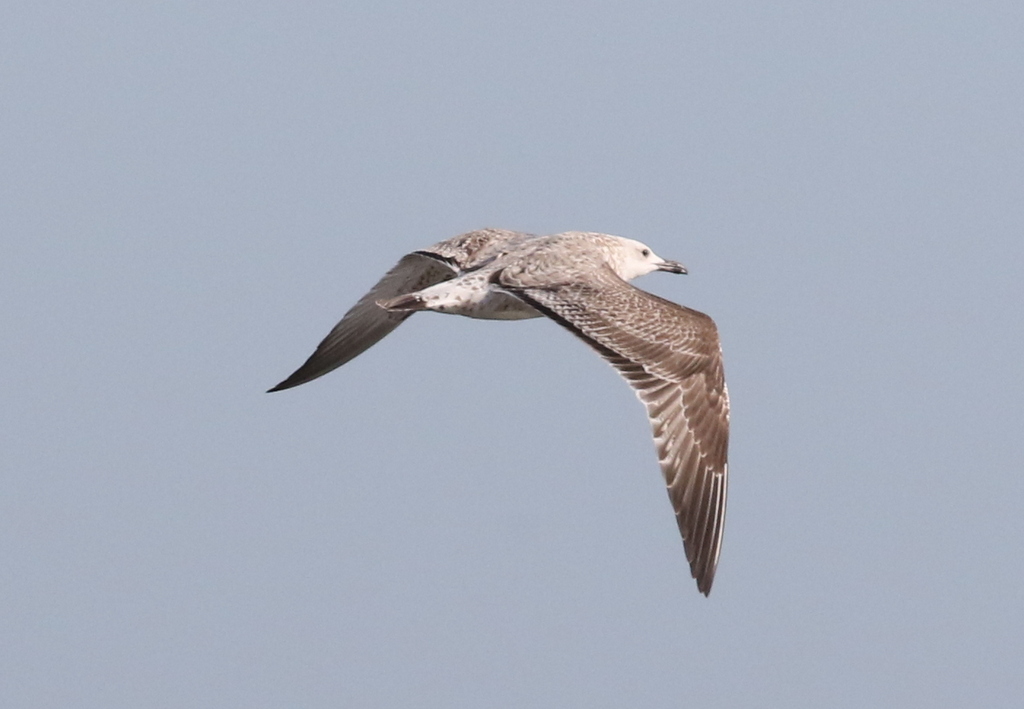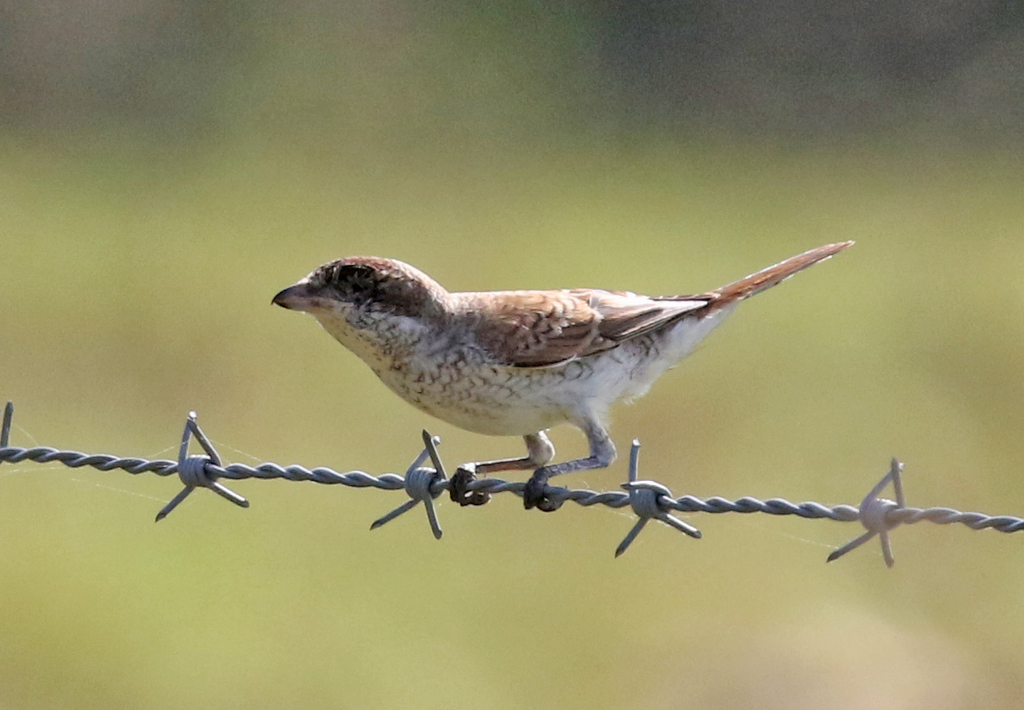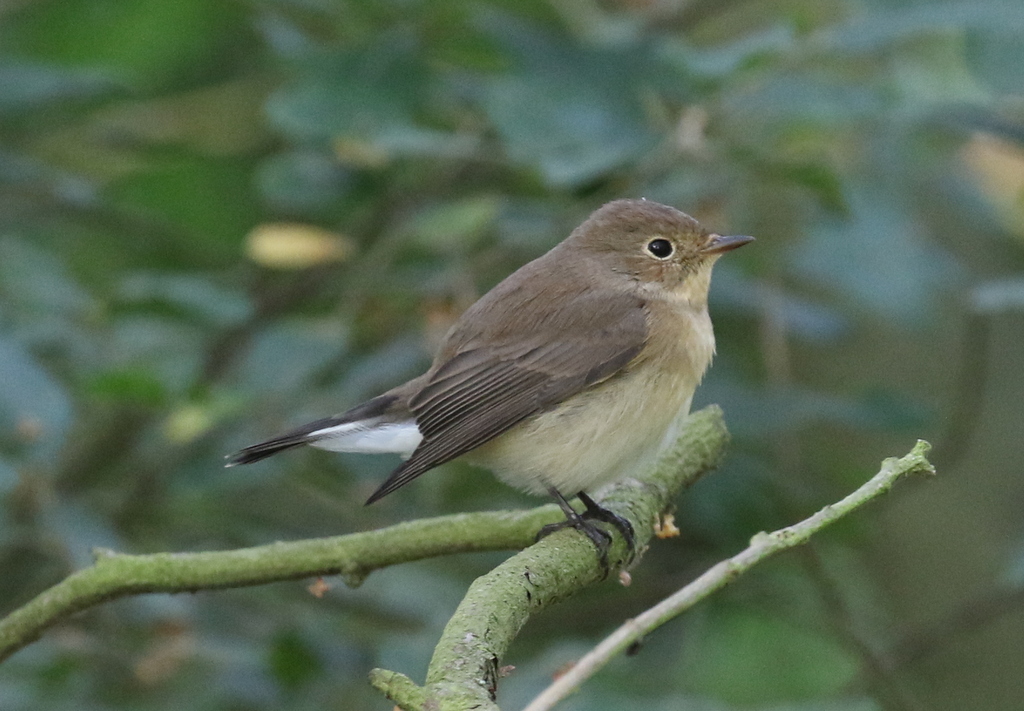Day 2 of a three day Autumn Tour & Wader Spectacular. It was another sunny day, more blue skies, and although it was breezy again it wasn’t quite as windy as yesterday.
We made our way down to Stiffkey Greens to start the day. The wind seemed to have dropped a bit overnight, so we thought we might stand a chance of finding a few migrants in the coastal bushes. The tide was in, and it was a big tide today backed by the ENE wind, so the saltmarsh was completely covered. A small group of people were out in the water in wetsuits and bathing caps, trying to rescue a sailing boat which had come adrift from somewhere and was floating out in the middle of where the saltmarsh would be later.
The coastal path to the west is often a bit quieter, but the track to the east was flooded by the tide today, so there were more people than usual along here – blackberry pickers, dog walkers, holidaying families with young children out for a walk. Consequently, we didn’t find much in the bushes on the way down to the whirligig.
We kept stopping to scan the flooded saltmarsh, where lots of birds had been displaced by the height of the water today. Little groups of Redshanks were trying to roost around the small islands of vegetation and bushes which were still exposed, with others flying round in lines low over the water looking for somewhere to land. We heard a Greenshank calling, and looked out to see it flying across.
A Spoonbill flew past, heading off east, presumably to roost on Stiffkey Fen. Several Little Egrets were also standing out in the clumps of vegetation, with others flying past. Everything was looking for somewhere to roost over the high tide. Flocks of ducks were flying round too, mainly Wigeon, the males flashing their white wing coverts. A couple of Brent Geese flew past.

Lots of small birds had been pushed off the saltmarsh by the tide today too. A small flock of Skylarks came up over the stubble field just inland. Several Reed Buntings were calling in the brambles and suaeda bushes. Four small birds flew low across over the water in the distance. We only caught them as they disappeared off east – they looked like Lapland Buntings, but they were too far out to be sure and we lost sight of them behind the bushes.
A couple of Marsh Harriers were out hunting, patrolling up and down the lines of higher ground. Continuing on to the whirligig, it was still a bit too windy, despite lighter winds than yesterday, and the brambles here were quiet. There was more activity in the bushes just beyond, several Blackcaps flitting around in the brambles and elders, two or three Blackbirds and a Song Thrush, the latter possibly a continental migrant in for the winter. A Brown Hare sunning itself under the brambles had possibly also been pushed in off the saltmarsh.
A Wheatear flew up off the field beyond the hedge and landed on the top of a hawthorn. It was swaying around, struggling to perch in the wind, before it dropped back down out of view.

We decided to head back and find somewhere more sheltered. When we got back to the car park, we turned to look out over the saltmarsh and noticed a distinctive large gull flying past. It looked very white-headed, pale grey-mantled and contrastingly dark-winged with dark greater coverts, with a very white tail base and black terminal band. We managed to just grab a couple of photos before it headed away. It was a young Caspian Gull, in its 1st calendar year, 1st winter – not a place we usually expect to see one, a welcome bonus.

We headed for Wells and down beach road where we parked in the beach car park. As we walked in past the boating lake towards the trees, we could see several Little Grebes out on the water.
Cutting in through the birches towards the Dell, we found a couple of birders watching a Redstart. We stopped, and a Pied Flycatcher was flicking about in the trees above too. A good start, and a sign that things had possibly arrived overnight. The birds appeared to be following a tit flock – warblers and flycatchers will often do that here and finding the tits is often the best way to find everything else.

They started to move away rapidly through the birches and we didn’t want to lose them. We could hear the Pied Flycatcher calling much further ahead now, so we followed as quickly as we could. We managed to get ahead of them, and were suddenly surrounded by birds – lots of tits, Long-tailed Tits, Coal Tits; tiny Goldcrests; one or two Treecreepers working their way up the trunks; a couple of Great Spotted Woodpeckers.
A Pied Flycatcher appeared and perched up nicely on a small birch in front of us, making occasional sallies out after insects. Hard to tell if it was the same one we saw earlier, but probably not – there were several in here today.

Following the flock round through the trees on the north side of the Dell, we saw a small shape come up out of the bracken on the top of the bank. It was a Yellow-browed Warbler, and we watched it flicking around in the birches. It disappeared further into the trees and we lost sight of it in all the foliage. We walked round to the other side, and eventually the flock worked its way towards us. The Yellow-browed Warbler appeared in the birches again here briefly.
The tit flock headed on through the trees and we had to take a path away from them to get round to where they appeared to be going. It only took a few seconds, but when we got to the other side they had completely disappeared – as they have a habit of doing!
We decided to walk across to the more open area to the south, to see if we could find anything in the bushes. There is a gap at the back where you can see out across the grazing marshes, and as we rounded the hawthorns a bird flew up onto the barbed wire fence right in front of us – a Red-backed Shrike!

The Red-backed Shrike dropped down to the ground and flew back up to the fence a little further along. We had a longer view of it through our binoculars now – we could see it was very similar to the Brown Shrike we had seen yesterday, also a 1st winter. It was more heavily marked with dark crescents on its upperparts, greyer on the head and nape, and longer-winged too. We were looking into the light from here, and we didn’t notice until we looked at the photos later this it was actually missing its left eye.
It dropped down again, and then shot off across the field to the fence on the other side. We got it in the scope now, and had some more prolonged views. Red-backed Shrikes used to be common breeding birds in the UK, but after a long decline died out as regular breeders in the 1980s, a victim of loss of habitat and intensification of agriculture. They are now mainly scarce passage migrants here, dropping in on their way between their breeding grounds on the continent and their wintering areas in West Africa, although the odd pair sometimes still stays to breed. A nice find for the group!
There were lots of Curlews out on the grazing marshes, and a flock of Pink-footed Geese loafing in the grass in the field beyond. We had a look at them in the scopes too. Two Red Kites were hanging in the air further back towards the main road.
Back on the main path, we made our way on west. There were a couple of Chiffchaffs in the birches by the track and we heard Long-tailed Tits in here too, but they disappeared out the back and along the far edge of the field beyond before we could get a look through them.
There was nothing at the drinking pool – it is very dry now – and not much activity in the deciduous trees further west. As we turned to come back, one of the group spotted some movement under the bushes, a Redstart. We stopped to watch it, sitting motionless for several minutes before flitting across and landing again. As we started to to walk on, we noticed a second Redstart under the trees a little further along.

We planned to head back to the Dell to try to find one of the tit flocks again. On our way, we met someone who said that there had been a Red-breasted Flycatcher earlier by the main path, with the tits. There was no sign of them there, so we continued round into the Dell meadow. We found a tit flock in the birches on the north side and had just stopped to look through them when we received a message to say the Red-breasted Flycatcher was across the other side.
The tits moved deeper into the trees, so we went across to look for the Red-breasted Flycatcher. Unfortunately it had moved off again and disappeared – it wasn’t clear whether it was with the tits now or on its own. It had been a long morning, and it would be getting late for lunch if we spent too long chasing round now, so we decided to head back to the car park to get something to eat.
After lunch back in the car park in the sunshine, and a sit down, we headed back in to the woods to look for the Red-breasted Flycatcher again. We walked round the east side of the Dell first, where it had been earlier. We quickly found a tit flock in the trees here, but it was moving fast. We managed to follow it, but it disappeared over the main track and off towards the caravan site before we could tell if there was anything interesting with it.
Back round to the north side of Dell, a Yellow-browed Warbler had just been seen in here again. We couldn’t find it now, but we did see three Pied Flycatchers, and two or three Chiffchaffs in the birches. We seemed to be chasing our tails, so we walked back out to the main path, planning to look in the birches the other side and regroup, and immediately found a tit flock. We had only just stopped to look through them when we got a call from a friend to say that the Red-breasted Flycatcher was back in the trees in the south-east corner of the Dell.
We hurried round and the Red-breasted Flycatcher was now showing well, flitting around down low in the tangles of branches beneath the birches. It was another young bird, a 1st winter – with a dull pale buffy-orange wash across its breast (the adult males had a more obvious orange-red breast). When it perched it would occasionally cock its tail up, and it was possible to see the white sides to the base of the black tail. It seemed to be settled here now, on its own, doing a small circuit up and down in the trees.

We spent some time sitting on the bank watching it quietly feeding under the trees. Red-breasted Flycatcher is another scarce visitor here, more in autumn than spring. They breed in Eastern Europe, up through southern Scandinavia and migrate to West Asia for the winter. Another great autumn migrant for us to catch up with.
It had been very productive in the Woods today, but we had spent enough time in the trees now, so we made our way back out to the car park. There was still a bit of time, so we walked over to loon in the harbour. The beach was busy, but there were lots of waders out on the mud the other side of the harbour channel, so we set up the scopes to look through them.
There were lots of Oystercatchers, Grey Plovers and Knot. Several Bar-tailed Godwits were on the wet sand opposite, and we had a good look at them through the scopes. A few Turnstones were feeding along the far edge of the channel and further back, we found a couple of Ringed Plovers. A small group of Brent Geese was on the mud too.
There would be plenty of time for more waders tomorrow. It had been a great day, with some really good birds. For now, it was time to call it a day – we had an early start planned for tomorrow.
















